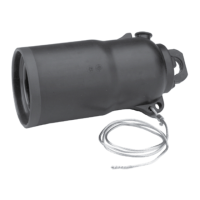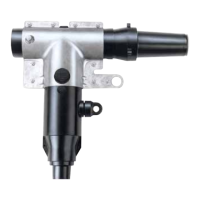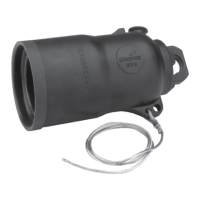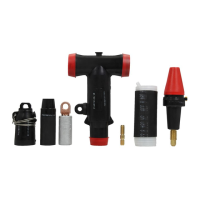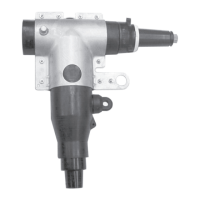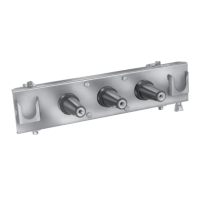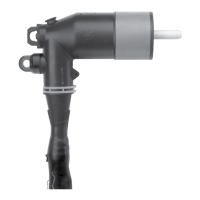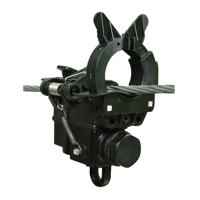To avoid potential cycling of the regulator, set the high-and
low-voltage limits at lest two volts above and below the
upper and lower bandwidth limits. This will establish a
"grey zone" between the high-and low-voltage limits and
the upper and lower limits. When the output voltage is
within this "grey zone", the control will not perform any tap
changes that would take the output voltage closer to the
limit. If the voltage is directly on the inner edge of the grey
zone, the control will allow one tap change to permit the
voltage to enter the grey zone by as much as 0.7 V.
Voltage reduction
An ideal application for system load management is
at the distribution voltage regulator. Voltage reduction
capabilities within the regulator control permit it to trigger
the regulator to reduce voltage during situations where
power demands surpass the available capacity and where
there are extraordinary peak loads. The control offers three
modes of voltage reduction: Local/Digital Remote, analog
Remote/Latch, and analog Remote/Pulse. All modes operate
for forward or reverse power flow conditions. For further
information on the Local/Digital Remote mode, see below.
Analog Remote/Latch and Remote/Pulse are discussed in
the Analog SCADA section starting later in this section of
this manual.
All voltage reduction modes of the control work by
calculating an effective set voltage as follows:
Effective Set Voltage = Set Voltage x [1- (% reduction)]
Example: If the set voltage = 123 V and voltage reduction of
4.6% is active, the regulator will regulate the compensated
voltage to 117.3 V, that is, tap down 5.7 V.
When any mode of voltage reduction is in effect, the
Voltage Reduction indicator is turned on. Voltage reduction
occurs after time out, as established by the time delay, FC
3 or FC 53, and the Control Operating Mode, FC 42. The
percent reduction in effect is displayed at FC 71.
Local/digital remote mode
Voltage reduction can be performed by selecting the Local/
Digital Remote mode of operation at FC 70 and then
entering into FC 72 the amount of reduction required as a
percentage of the set voltage. To turn voltage reduction off,
set FC 70 to “Off” or set FC 72 to 0%.
Soft ADD-AMP feature
This feature (FC 79) allows the user to set the regulator
for the Soft ADD-AMP feature locally at the control as well
as remotely through SCADA. The Soft ADD-AMP limits can
be overridden by a local operator running the tap-changer in
manual mode of operation. This is not the case for the “hard”
ADD-AMP limit switches on the position indicator face. The
Soft ADD-AMP feature can be overridden via digital SCADA if
the ADD-AMP mode is set to Remote Override.
In addition to using to the standard Soft ADD-AMP setting
using FC 79, Adaptive ADD-AMP is available as an advance
control feature. It allows the control to sense system and
voltage regulator conditions and turn on the Soft ADD-AMP
feature in reaction to specified conditions. Adaptive
ADD-AMP is controlled by the Programmable Input and
Output (PIO) capabilities of the CL-6 control which are
described in more detail in the Advanced Control Features
section of this manual.
Supervisory control and data acquisition (SCADA)
With its tap-changer, potential transformer, and current
transformer, the regulator is a likely candidate for a
Supervisory Control and Data Acquisition system where
the utility needs to have centralized voltage control for peak
shaving, energy conservation, or other purposes.
Regulators can be connected to Analog SCADA systems
where the regulator is controlled by contact closure and
the feedback is via a voltage transducer connected to the
voltage sensing circuit of the regulator control. The CL-6
control has a number of features which allow it to function
well on these types of systems. For details, see Analog
SCADA in this section.
The CL-6 control is also capable of real-time digital two-way
communication. For details, see Digital SCADA in this
section.
The control is also well suited to the user who does not
have a SCADA system but does have a need for detailed
information about the bus or feeder loading. For details, see
Data Retrieval and Settings Upload.
Data retrieval and settings uploading
The Com 1 port of the CL-6 control is a DB9-style RS-232
port located on the front of the control. It allows for
temporary connection to a PC. Using ProView NXG
software, the connection allows the user to reset all
metering and tap position maximum and minimum values,
upload settings which are specific to the control I.D.
number, and view data. The entire control database may be
downloaded.
Analysis of the data allows the user to verify the control
settings and analyze the conditions of the feeder as follows:
• At the moment of the downloading (instantaneous
metering)
• Maximum and minimum demand values since last reset
(time-tagged demand metering)
• The profile of salient parameters (profile recorder)
The Channel #1 baud rate is selectable at 300, 600, 1200,
2400, 4800, 9600, 19200, and 38400 Baud. It is factory set
to 9600 Baud.
84
CL-6 SERIES CONTROL INSTALLATION, OPERATION, AND MAINTENANCE INSTRUCTIONS MN225016EN January 2016

